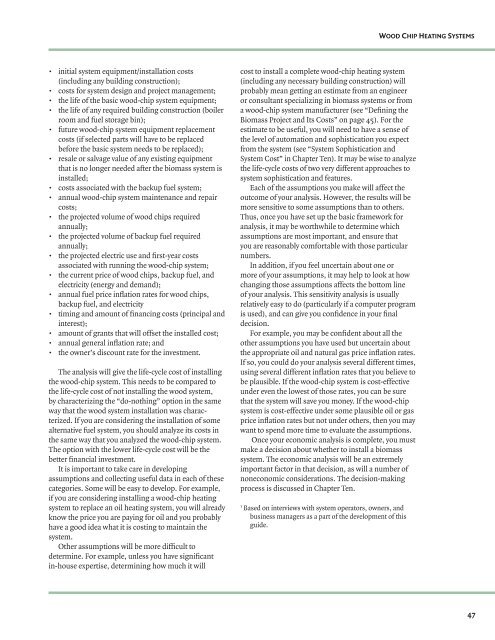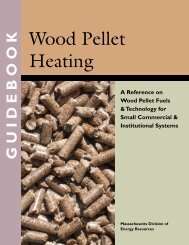Wood-Chip Heating Systems - Biomass Energy Resource Center
Wood-Chip Heating Systems - Biomass Energy Resource Center
Wood-Chip Heating Systems - Biomass Energy Resource Center
Create successful ePaper yourself
Turn your PDF publications into a flip-book with our unique Google optimized e-Paper software.
• initial system equipment/installation costs<br />
(including any building construction);<br />
• costs for system design and project management;<br />
• the life of the basic wood-chip system equipment;<br />
• the life of any required building construction (boiler<br />
room and fuel storage bin);<br />
• future wood-chip system equipment replacement<br />
costs (if selected parts will have to be replaced<br />
before the basic system needs to be replaced);<br />
• resale or salvage value of any existing equipment<br />
that is no longer needed after the biomass system is<br />
installed;<br />
• costs associated with the backup fuel system;<br />
• annual wood-chip system maintenance and repair<br />
costs;<br />
• the projected volume of wood chips required<br />
annually;<br />
• the projected volume of backup fuel required<br />
annually;<br />
• the projected electric use and fi rst-year costs<br />
associated with running the wood-chip system;<br />
• the current price of wood chips, backup fuel, and<br />
electricity (energy and demand);<br />
• annual fuel price infl ation rates for wood chips,<br />
backup fuel, and electricity<br />
• timing and amount of fi nancing costs (principal and<br />
interest);<br />
• amount of grants that will offset the installed cost;<br />
• annual general infl ation rate; and<br />
• the owner’s discount rate for the investment.<br />
The analysis will give the life-cycle cost of installing<br />
the wood-chip system. This needs to be compared to<br />
the life-cycle cost of not installing the wood system,<br />
by characterizing the “do-nothing” option in the same<br />
way that the wood system installation was characterized.<br />
If you are considering the installation of some<br />
alternative fuel system, you should analyze its costs in<br />
the same way that you analyzed the wood-chip system.<br />
The option with the lower life-cycle cost will be the<br />
better fi nancial investment.<br />
It is important to take care in developing<br />
assumptions and collecting useful data in each of these<br />
categories. Some will be easy to develop. For example,<br />
if you are considering installing a wood-chip heating<br />
system to replace an oil heating system, you will already<br />
know the price you are paying for oil and you probably<br />
have a good idea what it is costing to maintain the<br />
system.<br />
Other assumptions will be more diffi cult to<br />
determine. For example, unless you have signifi cant<br />
in-house expertise, determining how much it will<br />
cost to install a complete wood-chip heating system<br />
(including any necessary building construction) will<br />
probably mean getting an estimate from an engineer<br />
or consultant specializing in biomass systems or from<br />
a wood-chip system manufacturer (see “Defi ning the<br />
<strong>Biomass</strong> Project and Its Costs” on page 45). For the<br />
estimate to be useful, you will need to have a sense of<br />
the level of automation and sophistication you expect<br />
from the system (see “System Sophistication and<br />
System Cost” in Chapter Ten). It may be wise to analyze<br />
the life-cycle costs of two very different approaches to<br />
system sophistication and features.<br />
Each of the assumptions you make will affect the<br />
outcome of your analysis. However, the results will be<br />
more sensitive to some assumptions than to others.<br />
Thus, once you have set up the basic framework for<br />
analysis, it may be worthwhile to determine which<br />
assumptions are most important, and ensure that<br />
you are reasonably comfortable with those particular<br />
numbers.<br />
In addition, if you feel uncertain about one or<br />
more of your assumptions, it may help to look at how<br />
changing those assumptions affects the bottom line<br />
of your analysis. This sensitivity analysis is usually<br />
relatively easy to do (particularly if a computer program<br />
is used), and can give you confi dence in your fi nal<br />
decision.<br />
For example, you may be confi dent about all the<br />
other assumptions you have used but uncertain about<br />
the appropriate oil and natural gas price infl ation rates.<br />
If so, you could do your analysis several different times,<br />
using several different infl ation rates that you believe to<br />
be plausible. If the wood-chip system is cost-effective<br />
under even the lowest of those rates, you can be sure<br />
that the system will save you money. If the wood-chip<br />
system is cost-effective under some plausible oil or gas<br />
price infl ation rates but not under others, then you may<br />
want to spend more time to evaluate the assumptions.<br />
Once your economic analysis is complete, you must<br />
make a decision about whether to install a biomass<br />
system. The economic analysis will be an extremely<br />
important factor in that decision, as will a number of<br />
noneconomic considerations. The decision-making<br />
process is discussed in Chapter Ten.<br />
1 Based on interviews with system operators, owners, and<br />
business managers as a part of the development of this<br />
guide.<br />
WOOD CHIP HEATING SYSTEMS<br />
47





